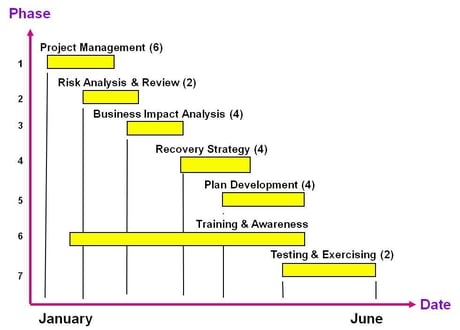
 Establish Timescale
Establish Timescale
This is the suggested time schedule (elapse time) for each typical BCP phase.
| Phase | BCM Phase | Length of Week |
| 1 | Project Management | 6 |
| 2 | Risk Analysis and Review | 2 |
| 3 | Business Impact Analysis | 4 |
| 4 | Business Continuity Strategy | 4 |
| 5 | Plan Development | 4 |
| 6 | Testing & Exercising | 2 |
| Total (Elapsed Time) | 22 weeks or 6 months | |
| 7 | Program Management | After the 6th month |
Project Schedule & Elapse Time
Each phase is overlapped and broken down into detailed steps. Template 6: BCP Action Steps and Tasks which describes the tasks and activities for a typical BCP project schedule

Typical BCP Project Schedule
Get Agreement on Dates
![]() When assigning tasks to BCP team members, it is unwise to simply state, “I need this task completed by a specific date.” Without any input to the scheduling process, the BCP project team member may not accept accountability for meeting the deadline. Instead, ask, “How soon can you complete this task?” Negotiate if necessary, but be sure to get an agreement, and to hold the BCP team member accountable for meeting the agreed-upon date.
When assigning tasks to BCP team members, it is unwise to simply state, “I need this task completed by a specific date.” Without any input to the scheduling process, the BCP project team member may not accept accountability for meeting the deadline. Instead, ask, “How soon can you complete this task?” Negotiate if necessary, but be sure to get an agreement, and to hold the BCP team member accountable for meeting the agreed-upon date.
Set Realistic Timeframe
The key project success is getting the BCP project finished on time. All too often, an Organization BCM Coordinator adopts a time period for the BCP project, which is too short. This can be because it is set by management or someone else who is not aware of the true size of the BCP project, or because the Organization BCM Coordinator feels that the Executive Management will not pass a BCP project that is too large or long. Sometimes this is the organizational culture in which case, there is nothing you can do about it. Otherwise, you must take extra care to not underestimate. Remember that people do get sick, do resign, and do go on leave when you least expect them to.
The true size of the BCP project cannot be determined until all the critical business functions and IT applications have been identified. By this time you are well into the BCP project. It is better to overestimate at the early stages; chances are that, as you progress, you will find that you still have underestimated.
Beware of Unrealistic Target Dates
Often, I have found inexperienced Organization BCM Coordinators setting unrealistic deadlines and there was no way the schedules could have been met. The Executive Management is usually not aware that the BCP project is not just about going straight into writing a set of recovery procedures.
It is important to be aware of other organizational activities, personal time commitments, and projects contending for the same resources and we will need to allocate additional time so that the resources can be performed well in your BCP project. This organizational project may include year-end retreats, annual budgeting, staff appraisal, school holidays, and long national holidays.
It is critical to scope a BCP project complete within an elapsed time of fewer than 12 months. I have observed that a project schedule that exceeded 12 months usually results in failure to complete. This is due to project fatigue, loss of interest by the Executive Management as they focus on other higher priority projects, and loss of project members due to internal transfers and turnovers.
Minimize Unapproved Deviations
Once the BCP project has started, there may be pressure to modify the scope or objectives. This should be resisted if possible. If it is not possible, ensure that the deviations are explicitly approved by the Executive Management, and any implications these may have on the BCP project schedule or change in sourcing requirements are understood and accepted.
Time Commitment by BU BCM Coordinators
One approach that will help ease the pain is a clear proclamation by the Organization BCM Coordinator with the BCP project team that while recovery plans live forever, their initial development should take only a short time, if everyone puts in their effort. There is an end in sight. With the appropriate support obtained as part of Executive Management buy-in, the Organization BCM Coordinator should promise that the BCP project will be completed within six to nine months, at which time initial walkthrough testing can occur.
I often provide an estimation of 8 to 10 man-days of time commitment from each BU BCM Coordinator. It is extremely difficult to be precise about the percentage of time commitment. In small business units, for instance, the time may very well be 10% or less. In larger business units, a time commitment of 15% to 25% may be closer to correct. However, should the workload of any single individual within a business unit exceed 25%, then the Head of Business Unit should consider breaking up the business functions of the business unit, and spreading the workload out to other personnel.
For example, if the business unit is the operations (back office) business unit, and the workload appears to be over 25% for the designated BU BCM Coordinator, the Head of Business Unit could split the task in two. For example, the Trade Finance and Treasury Operations business unit could assign two BU BCM Coordinators, each of whom would spend less than 25% of the time developing two plans for this business unit, divided along functional lines.
BCM Project Management StepsClick to find out more about the detailed requirement for each steps |
|||||
| Back To | 1 | 2 | 3 | 4 | 5 |
 |
 |
 |
 |
 |
 |
| 6 | 7 | 8 | 9 | 10 | 11 |
 |
 |
 |
 |
 |
 |
Reference
Goh, M. H. (2021). Managing Your Business Continuity Planning Project. Business Continuity Management Planning Series (3rd ed.). Singapore: GMH Pte Ltd.
Extracted from "Chapter 5: Step 7: Develop Action Plan Schedule"











![FAQ [BL-B-3]](https://no-cache.hubspot.com/cta/default/3893111/b3824ba1-7aa1-4eb6-bef8-94f57121c5ae.png)


